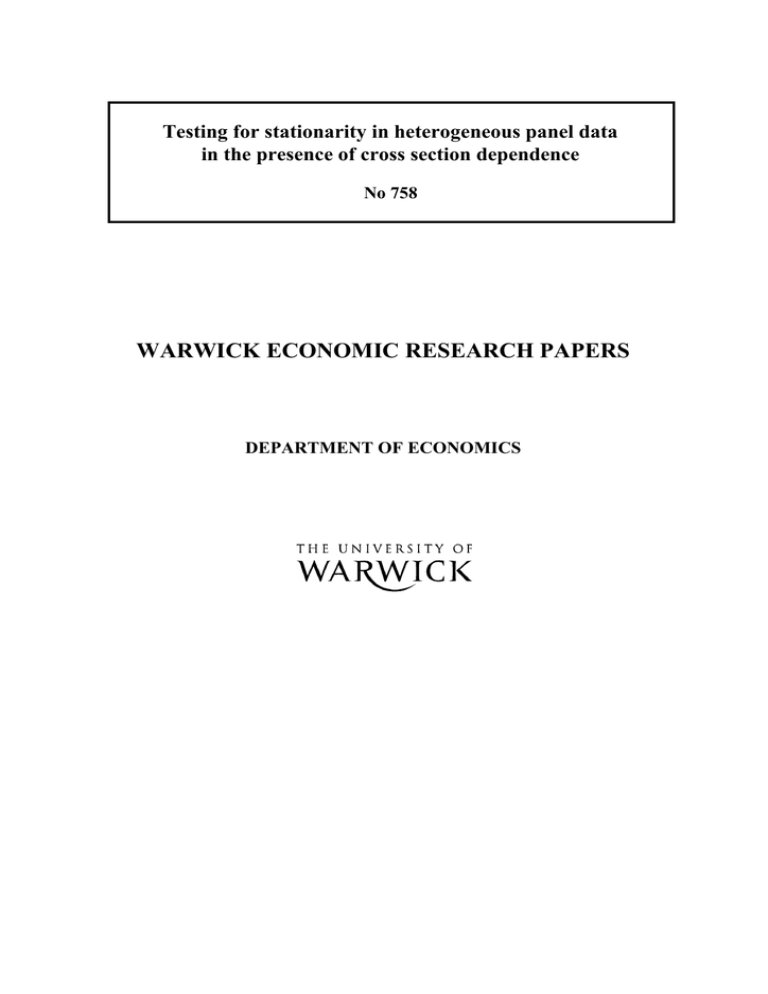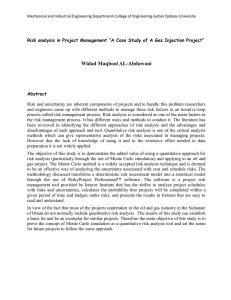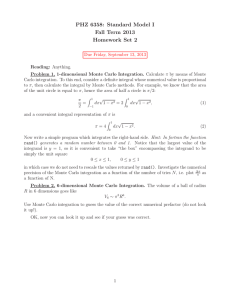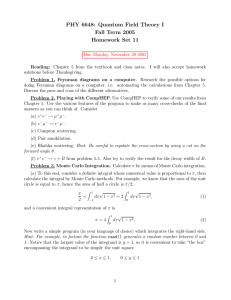WARWICK ECONOMIC RESEARCH PAPERS Testing for stationarity in heterogeneous panel data
advertisement

Testing for stationarity in heterogeneous panel data in the presence of cross section dependence No 758 WARWICK ECONOMIC RESEARCH PAPERS DEPARTMENT OF ECONOMICS Testing for stationarity in heterogeneous panel data in the presence of cross section dependence Monica Giuliettiy Aston Business School University of Aston United Kingdom Jesus Oteroz Facultad de Economía Universidad del Rosario Colombia Jeremy Smith x Department of Economics University of Warwick United Kingdom September 2006 Abstract The panel variant of the KPSS tests developed by Hadri (2000) for the null of stationarity su¤ers from size distortions in the presence of cross section dependence. However, applying the bootstrap methodology we …nd that these tests are approximately correctly sized. JEL Classi…cation: C12; C15; C22; C23 Keywords: Heterogeneous dynamic panels, Monte Carlo, bootstrap, unit root tests, cross section dependence. The authors would like to thank participants at the 13th International Panel Data Conference held in Cambridge. y E-mail: m.giulietti@aston.ac.uk z E-mail: jotero@urosario.edu.co x E-mail: jeremy.smith@warwick.ac.uk 1 Introduction A number of alternative procedures have been proposed to test for the presence of unit roots in dynamic heterogeneous panels, see e.g. Im, Pesaran, and Shin (2003) (IPS) and Maddala and Wu (1999) (MW). These authors test the null hypothesis of a unit root against the alternative of at least one stationary series, by using the (Augmented) Dickey-Fuller (ADF) statistic across the cross-sectional units of the panel. By contrast, Hadri (2000) proposed an LM procedure to test the null hypothesis that all of the individual series are stationary (either around a mean or around a trend) against the alternative of at least a single unit root in the panel. The two LM tests proposed by Hadri (2000) are panel versions of the test developed by Kwiatkowski, Phillips, Schmidt, and Shin (1992). A critical assumption underlying these tests is that of cross section independence among the individual time series in the panel and both the MW and IPS tests exhibit severe size distortions in the presence of cross-sectional dependence. This paper investigates the performance of the Hadri (2000) tests in the presence of crosssection dependence. Based on Monte Carlo simulations we …nd that the Hadri (2000) tests also su¤er from severe size distortion, and we use the bootstrap method to allow for potential cross-sectional dependency. The plan of the paper is as follows. Section 2 brie‡y reviews the Hadri (2000) approach to unit root testing in panels. Section 3 presents the design of the Monte Carlo simulation and the main results. 2 The Hadri tests Hadri (2000) proposes residual based Lagrange Multiplier tests for the null hypothesis that the time series for each cross section unit, i, are stationary around a level or around a deterministic time trend, against the alternative of at least a single unit root. Following Hadri (2000), consider the models: yit = rit + "it , (1) and yit = rit + it + "it, (2) where rit is a random walk, rit = rit 1 1 + uit , (3) and "it and uit are mutually independent normal distributions. Also, "it and uit are i:i:d: across i and over t, with E ["it ] = 0, E "2it = 2 " > 0, E [uit ] = 0, E u2it = 2 u 0, t = 1; :::; T and i = 1; :::; N . Let ^"it ( ^"it ) be the residuals from the regression of yi on an intercept, for model (1), (on an intercept and a linear trend term, for model (2)). Let ^ 2" ( ^ 2" ) be a consistent estimator of the error variance (corrected for degrees of freedom) from the appropriate regression, which are given by: ^ 2" = 1 N (T 1) N X T X 2) N X T X and ^ 2" = Also, let Sitl 1 N (T ^"it 2 ; i=1 t=1 ^"it 2 : i=1 t=1 be the partial sum process of the residuals, Sitl = t X ^"lij ; l = ; : j=1 Then the LM statistic is: N 1 P T 1 P Sl 2 2 N i=1 T t=1 it LMl = ; l= ; : ^ 2" Hadri (2000) considers the standardised statistics: p N LM Z = ) N (0; 1) ; and Z = p N (LM ) ) N (0; 1) : The mean and the variance of the random variable Z are The mean and the variance of the random variable Z are 3 (4) = (5) = 1 6 1 15 and 2 and 2 = 1 45 , 11 6300 , = respectively. respectively. Monte Carlo simulations and results We use Monte Carlo simulations to examine the e¤ects of cross-section dependence on the size and power of Z and Z . Following Hadri (2000), to investigate the size of Z and Z the data-generating process (DGP) for model (1) is: 2 yit = i + "it ; while for model (2) the corresponding DGP is given by: yit = i + it + "it ; where "t are i:i:d: N (0; 1) under the null hypothesis. We generate U [0; 2], where U stands for a uniform distribution; i and i i U [0; 10] and i are generated once and then …xed in all replications. We consider the cases of N = (15; 25; 50; 100) and T = (15; 25; 50), where the …rst 100 time observations for each cross-sectional unit are discarded. A total of 2,000 replications are used in computing the empirical size and power of the tests at the 5% nominal level. The Monte Carlo experiments of Hadri (2000) demonstrate that these tests have good size properties for T and N su¢ ciently large and this observation is consistent with our own …ndings (which are not reported here to save space). However, even for relatively large N and T , and in line with the results on both the IPS and the MW panel unit root tests, the tests of Hadri (2000) su¤er from severe size distortions in the presence of cross-sectional dependence, as can be seen in Table 1, where following O’Connell (1998) we assume that the variance-covariance matrix of the disturbance vector "t = ["1t ; "2t ; :::; "N t ] has the form: E "t "0t = 0 B B =B @ 1 1 ! ::: ! ! 1 ::: ! C C .. .. . . .. C ; . . A . . ! ! ::: 1 ! < 1: In the Monte Carlo experiments, ! = (0:3; 0:5; 0:7; 0:9), with ! = 0:0 being the case of crosssectional independence considered by Hadri (2000). We note that the size distortion increases as the strength of the cross-sectional dependence, !, increases. To correct the size distortion caused by cross-sectional dependence, we follow Maddala and Wu (1999) and more recently Chang (2004), who considered bootstrapping unit root tests. To implement this approach in the context of the Hadri tests, we bootstrap the residuals from either a regression of yi on a constant for the Z test or yi on a constant and a trend for the 3 Z test. As suggested by Maddala and Wu (1999) (p.646), we resample the residuals with the cross-section index …xed, so that we preserve the cross-correlation structure of the error term. Results are based on 2,000 Monte Carlo replications, with 100 bootstrap replications used to generate the bootstrap distributions of the tests. The major conclusion that one can draw is that bootstrapping the errors seems to largely correct for the over-size problem (Table 1), although for T = 15 and T = 25 there is evidence to suggest that even the bootstrapped test statistics are slightly over-sized. Finally, to investigate the empirical power of the Hadri tests we assume that (0:001; 0:1; 1; 10; 100), with = 0, i.e. 2 u = 2= 2 u " = = 1 corresponding to a pure random walk in yt ; notice that = 0, corresponds to the case where yt is stationary (these parameter values are similar to those used by KPSS and Hadri). The results reported in Table 2 show that for given T , N and ! power increases with . We note that for …xed T , N and , as the degree of cross-sectional dependency, !, increases, power falls. 4 Table 1. Empirical size of the Hadri tests with cross section dependence Z statistic Z statistic T N ! N(0,1) Bootstrap N(0,1) Bootstrap 15 15 0.3 9.80 5.75 6.30 5.35 0.5 14.45 6.20 10.90 5.05 0.7 18.10 6.30 14.35 5.30 0.9 21.10 6.25 17.85 5.05 15 25 0.3 12.10 6.75 9.05 5.65 0.5 16.55 6.50 14.50 6.00 0.7 20.10 6.60 19.35 6.10 0.9 22.80 6.30 22.80 6.15 15 50 0.3 16.15 6.35 12.25 4.65 0.5 21.60 6.35 18.85 5.45 0.7 23.85 6.25 24.20 5.80 0.9 25.00 6.25 26.25 6.20 15 100 0.3 18.15 5.55 15.65 5.55 24.05 5.70 22.95 4.90 0.5 0.7 27.70 5.90 27.05 5.15 0.9 29.10 5.75 30.35 6.00 25 15 0.3 11.80 6.60 10.45 6.80 0.5 16.50 5.85 15.95 5.80 0.7 19.05 6.50 19.65 5.50 0.9 20.40 6.25 21.50 5.55 25 25 0.3 11.25 5.40 12.15 6.05 0.5 15.70 5.30 17.40 6.05 0.7 18.90 5.60 22.05 6.60 0.9 21.30 4.95 25.85 6.10 17.90 6.95 16.35 6.10 25 50 0.3 0.5 23.00 6.60 22.35 6.30 0.7 24.50 6.80 26.85 6.50 0.9 26.25 6.95 28.90 5.95 25 100 0.3 16.95 4.55 19.60 4.60 0.5 22.65 4.95 24.65 4.40 0.7 25.40 5.05 27.10 4.80 0.9 27.60 4.75 27.65 5.10 50 15 0.3 9.30 4.95 10.50 5.55 0.5 14.35 5.40 15.10 5.80 17.25 5.85 19.60 6.00 0.7 19.65 6.15 23.40 6.10 0.9 50 25 0.3 11.65 4.85 12.20 4.65 16.10 4.50 17.45 4.50 0.5 19.75 5.05 20.55 4.55 0.7 22.15 4.70 24.05 4.95 0.9 15.95 5.55 16.20 4.90 50 50 0.3 19.95 5.25 22.35 4.65 0.5 22.30 4.85 25.00 4.60 0.7 23.50 4.80 26.65 4.10 0.9 50 100 0.3 18.85 4.90 19.35 4.40 23.25 4.70 24.20 5.25 0.5 27.15 5.40 27.45 5.20 0.7 27.70 5.55 29.65 4.95 0.9 The 95% con…dence intervals for 5% sign…cance levels based on 2,000 replications are (4.04,5.96). 5 Table 2. Power of bootstrapped Hadri tests with cross section dependence Z statistic Z statistic T N 0.001 0.01 0.1 1 100 0.001 0.01 0.1 1 15 15 0.3 5.90 10.35 64.25 99.95 100.00 5.50 6.30 19.95 95.10 0.5 6.20 9.35 58.55 99.95 100.00 5.05 6.10 17.15 93.40 0.7 6.90 8.95 51.75 99.90 100.00 5.40 5.95 14.75 91.90 0.9 6.40 8.65 44.00 99.80 100.00 5.25 5.85 13.05 89.20 15 25 0.3 6.65 11.65 75.25 100.00 100.00 5.80 7.00 22.40 98.50 0.5 6.80 9.45 66.65 100.00 100.00 5.95 7.20 19.60 97.30 0.7 7.15 8.85 56.75 100.00 100.00 6.25 7.35 16.70 95.25 0.9 6.55 8.35 48.15 100.00 100.00 6.30 7.15 15.80 92.75 15 50 0.3 6.75 10.90 83.40 100.00 100.00 4.75 5.65 24.80 99.80 0.5 6.85 9.25 72.40 100.00 100.00 5.55 6.45 19.70 99.40 0.7 6.65 8.80 60.10 100.00 100.00 5.85 6.80 17.40 98.55 0.9 6.55 8.20 48.65 100.00 100.00 6.35 7.10 16.40 96.45 5.90 10.30 89.30 100.00 100.00 5.60 6.55 24.85 99.95 15 100 0.3 0.5 5.85 9.15 77.65 100.00 100.00 5.05 5.95 20.85 99.90 0.7 6.25 8.45 63.30 100.00 100.00 5.35 6.30 16.85 99.05 0.9 6.05 7.85 50.60 100.00 100.00 6.05 7.15 15.80 97.50 25 15 0.3 7.30 26.45 98.65 100.00 100.00 6.90 10.15 69.50 100.00 0.5 7.30 18.45 97.70 100.00 100.00 5.95 8.55 57.35 100.00 0.7 7.00 14.00 96.35 100.00 100.00 5.55 7.40 45.15 100.00 0.9 6.45 11.10 94.40 100.00 100.00 5.85 6.75 36.30 100.00 25 25 0.3 6.20 25.25 99.75 100.00 100.00 6.30 9.95 80.25 100.00 0.5 5.95 15.15 99.50 100.00 100.00 6.55 8.85 65.20 100.00 0.7 5.65 11.70 98.55 100.00 100.00 6.65 8.45 47.00 100.00 5.25 9.55 96.75 100.00 100.00 6.30 7.65 36.40 100.00 0.9 25 50 0.3 8.05 29.05 100.00 100.00 100.00 6.40 9.55 89.45 100.00 0.5 7.20 17.95 99.95 100.00 100.00 6.40 8.25 70.05 100.00 0.7 7.65 12.80 99.80 100.00 100.00 6.50 8.15 51.60 100.00 0.9 7.35 11.50 99.30 100.00 100.00 6.15 7.55 39.20 100.00 25 100 0.3 5.10 25.60 100.00 100.00 100.00 4.85 8.35 94.20 100.00 0.5 5.55 14.05 100.00 100.00 100.00 4.55 6.85 72.55 100.00 0.7 5.45 10.65 99.90 100.00 100.00 5.00 6.25 51.50 100.00 5.40 9.55 99.50 100.00 100.00 5.15 6.30 35.95 100.00 0.9 50 15 0.3 10.05 88.25 100.00 100.00 100.00 6.80 28.95 100.00 100.00 8.25 77.05 100.00 100.00 100.00 6.55 17.75 99.90 100.00 0.5 7.20 61.65 100.00 100.00 100.00 6.20 13.35 99.70 100.00 0.7 0.9 6.90 46.80 100.00 100.00 100.00 6.80 11.90 98.80 100.00 9.80 95.15 100.00 100.00 100.00 5.80 29.50 100.00 100.00 50 25 0.3 7.05 83.70 100.00 100.00 100.00 5.05 15.85 99.95 100.00 0.5 6.75 65.00 100.00 100.00 100.00 4.75 11.35 99.95 100.00 0.7 5.95 47.30 100.00 100.00 100.00 5.20 10.40 99.45 100.00 0.9 5.55 33.65 100.00 100.00 50 50 0.3 10.40 99.40 100.00 100.00 100.00 7.30 89.95 100.00 100.00 100.00 5.45 18.15 100.00 100.00 0.5 6.15 69.55 100.00 100.00 100.00 4.95 11.65 100.00 100.00 0.7 0.9 5.95 47.15 100.00 100.00 100.00 4.55 9.85 99.90 100.00 9.15 99.80 100.00 100.00 100.00 5.50 32.25 100.00 100.00 50 100 0.3 6.95 93.55 100.00 100.00 100.00 5.75 14.90 100.00 100.00 0.5 6.65 72.35 100.00 100.00 100.00 5.45 12.20 100.00 100.00 0.7 6.85 48.45 100.00 100.00 100.00 5.20 10.65 99.95 100.00 0.9 6 100 100.00 100.00 100.00 100.00 100.00 100.00 100.00 100.00 100.00 100.00 100.00 100.00 100.00 100.00 100.00 100.00 100.00 100.00 100.00 100.00 100.00 100.00 100.00 100.00 100.00 100.00 100.00 100.00 100.00 100.00 100.00 100.00 100.00 100.00 100.00 100.00 100.00 100.00 100.00 100.00 100.00 100.00 100.00 100.00 100.00 100.00 100.00 100.00 References Chang, Y. (2004). Bootstrap unit root tests in panels with cross-sectional dependency. Journal of Econometrics 120, 263–293. Hadri, K. (2000). Testing for stationarity in heterogeneous panels. The Econometrics Journal 3, 148–161. Im, K., M. H. Pesaran, and Y. Shin (2003). Testing for unit roots in heterogeneous panels. Journal of Econometrics 115, 53–74. Kwiatkowski, D., P. C. B. Phillips, P. Schmidt, and Y. Shin (1992). Testing the null hypothesis of stationarity against the alternative of a unit root. Journal of Econometrics 54, 159–178. Maddala, G. S. and S. Wu (1999). A comparative study of unit root tests with panel data and a new simple test. Oxford Bulletin of Economics and Statistics 61, 631–652. O’Connell, P. G. J. (1998). The overvaluation of purchasing power parity. Journal of International Economics 44, 1–19. 7






